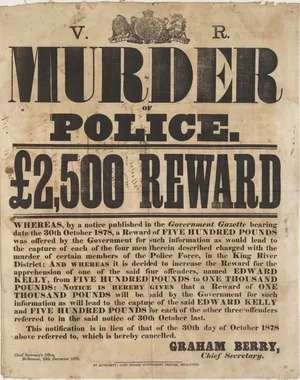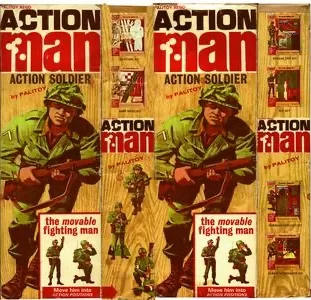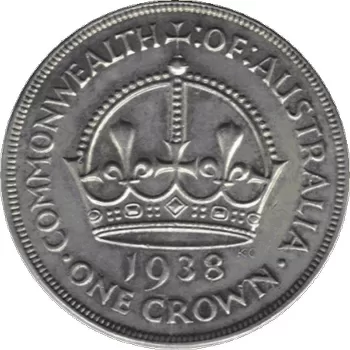Police posters and paperwork, especially those relating to notorious murder cases, are of interest to anyone concerned with social history or the quirks of human behaviour.
With duties that ranged from the registration of chimney-sweeps to the enforcement of restrictions on the movement of cattle, the police forces of Victorian Britain were as impatient as today’s police with the bureaucratic side of their work.
Officially, police files and records are never supposed to be released to the public, but printed and hand-written documents relating to police matters still find their way to ephemera fairs rather than to police museums, the County Record Office or the incinerator.
The things collectors look out for include notebooks, diaries, service records, commendations, warrant cards (both genuine and forged), instructional booklets, wanted posters, notices of all kinds, scrap-books and cuttings from old newspapers and magazines.
Most of these items were originally the property of officers who, in their years of service, gathered souvenirs associated with the cases on which they had worked.
Police Notebooks & Instructions
Every Victorian constable on the beat had his pencil and notebook, often smartly bound in leather with a metal catch to fasten it. However, books containing original jotted notes are extremely rare.
What a policeman was more likely to preserve was a neatly kept booklet listing his successful convictions. Personal notebooks of this kind tend to be kept in families proud of a great-grandfather who served in the force, along with scrapbooks of cuttings.
Of wider interest are the booklet and circulars printed for all members of the force, and the notices designed for display on police station notice boards and in public places throughout the country. No force has issued as many instructional booklets as the Metropolitan Police Force, which was founded in 1829 with a body of 3000 men.
As police procedure became more standardized, the ‘Met’ provided its men with booklets on subjects ranging from presentation of evidence to ju-jitsu and care of the feet. Self-education was encouraged.
An Edwardian constable could improve himself with the help of Punctuation, Grammar and Essays for the Police, and a Glossary of Words in Common Police Use.
When police forces adopted any technological innovation they had to provide their men with instructions as to its use. Thus booklets were issued on the care and maintenance of bicycles and how to use a police telephone. Detectives were instructed in the art of deriving clues from fingerprints.
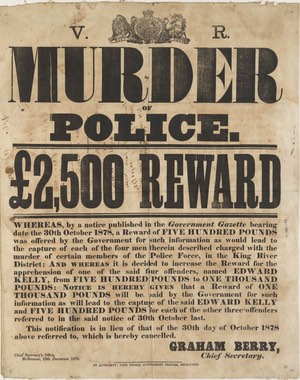

Ned Kelly Wanted Poster
The most sought-after items are those relating to bloody murders or audacious robberies, particularly old handbills. In the early 19th century, before the formation of organized police forces, posters offering rewards were put up on the authority of the local magistrates or by associations formed to combat crime and civil unrest.
Many posters of this period used the standard form of wording subsequently adopted by the police, beginning ‘Whereas some person or persons did, on the night of (Tuesday) last…’ and ending ‘The above reward will be paid to any person giving such information as shall lead to the conviction of the said offender or offenders’.
The many documents and other bits and pieces that made up police business of the past often paint a wider picture of bygone life and times. Anyone interested in social history will find such ephemera both fascinating and inexpensive to collect.
Collectible Police Printed Notices
You may be able to find old police notices dealing with such matters as cab ranks, licensing laws and street trading for single-figure sums, but anything relating to robbery or murder commands much higher prices.
Falling into this category would be an original Victorian reward poster, even for a long forgotten criminal who never caught the public imagination.
For ephemera concerned with notorious fugitives from justice, like Franz Muller, the first train murderer or Dr Crippen, the price can rise to four figures.
Copies of broadsheets describing the crimes and trials of the day can be good value, escalating in price according to the case. Ephemera relating to the crimes of Jack the Ripper can reach absurd figures.
COLLECTOR’S NOTES
Old posters and handbills make attractive and amusing curiosities for display and are especially popular. Posters fall into two categories: those advertising for police constables or senior ranks and those publicizing stolen items or wanted persons.
Most Victorian posters merely carry a description of the wanted person or persons, but by the early 1900s artists’ impressions and photographs were in widespread use, making posters of this period especially collectable.
Those showing such famous figures as Peter the Painter or Dr Crippen and his mistress, Ethel Le Neve, have been reproduced many times from the few examples that survive, so buyers should be wary when offered original wanted posters of criminals who have become house hold names.
A more promising area for the new collector might be printed notices that deal with the more mundane aspects of police work, such as traffic diversions, roads closed during Royal processions, regulations governing the length and width of costermongers’ barrows, licensing laws, bye-laws concerning litter on the street or parking places for hackney cabs.
Newspaper Reports
If you are unable to find original material directly concerned with crimes which have caught your imagination, you may like to build up a collection of newspaper reports.
The Victorians’ fascination with gruesome murder also created a ready market for broadsheets, ‘penny dreadfuls’ and sixpenny paperbacks which carried lurid accounts and highly imaginative sketches of the most sensational crimes of the day.
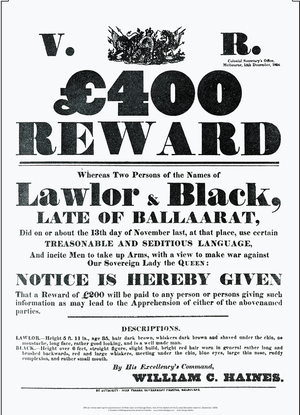
Most famous of these was the Illustrated Police News, a weekly publication which, despite its title, had no official connection with the police. Its front page was always filled with drawings: portraits of murderers and their victims and vignettes with titles like ‘the discovery of the body’ and ‘arrested on suspicion’.
If there were no shootings, stabbings or bloody corpses to depict, it would show sketches of a hanging, or ‘the noose is tightened’.
A more sober history of 19th-century crime is to be found in the official Police Gazette, first published in the early years of the century as Hue and Cry.
It contained lists and descriptions of wanted criminals, also the names of the many deserters from the Army and the Navy.
There are many different approaches to the collection of police ephemera, and much may be gained in times to come by keeping an eye on the future and collecting today’s throwaway material.
Lawlor & Black, Eureka Wanted Poster
Further Reading:
Jack the Ripper: Letters from Hell by Stewart P. Evans
The Whitechapel murders of 1888 captured the public’s attention not only for their ferocity but for an almost theatrical aspect in the form of letters from the purported killer. Evans and Skinner here expand upon the information presented in their The Ultimate Jack the Ripper Companion (LJ 12/00) by analyzing the more than 700 communications.
Most of the letters are regarded as tasteless pranks, including the famous “Dear Boss” missive that introduced the name “Jack the Ripper” (investigators credit this moniker to a tabloid journalist). However, a few are believed to be genuine, namely, the “From Hell” note accompanying half a kidney possibly removed from victim Catherine Eddowes.
Though perhaps frauds, the letters make interesting reading and bespeak the depravity of a society that would use gruesome murders as a means of entertainment. In addition to an analysis of their texts, this volume includes complete transcripts of all the letters held in the police files buttressed with numerous outstanding pictures of the original notes. While seasoned Ripperologists will love this book, the specificity limits its usefulness.
Therefore, this is recommended only for collections already sporting a general overview volume, e.g., John J. Eddleston’s noteworthy Jack the Ripper: An Encyclopedia
Over 100 years ago, a serial killer murdered a number of prostitutes in the East End of London. He was the first serial killer to terrorize a large city—at a time when literacy was rising and the power of the newspaper press was enormous. “Jack the Ripper” was the popular name that originated from letters sent to the press by somebody purporting to be the killer.
The gruesome murders immediately entered the popular consciousness, and interest in them remains high even today. Despite, or because of, the lack of agreement among scholars about many aspects of the murders (we do not even know how many victims he claimed), Jack the Ripper has spawned a vast number of books and films. But we are no closer to knowing his identity.
As an Amazon Associate, I earn from qualifying purchases.
See our other feature stories on Collectibles:
1. GI Joe – The doll for boys that put action into “action figure”
2. Police forensic artists explains age progressed images of missing persons
3. Postcard collecting ° Deltiology ° Propaganda Postcards of WWI & WWII
4. The world’s first Christmas card caused a controversy
5. Numismatics: Fake Coins to Watch For
6. What to collect in Barbershop Memorabilia
7. What are the world’s largest gold nuggets Famous Australian Gold Nuggets
See our other feature stories: Police Ephemera ° The value of Victorian reward posters
Violent arrest of Danny Lim by NSW Police
WANTED: Australian Federal Police appealing for information on wanted fugitive
Police forensic artists explains age progressed images of missing persons
Related stories
Heinz Schulz-Neudamm: Fritz Lang’s Metropolis Iconic Poster

